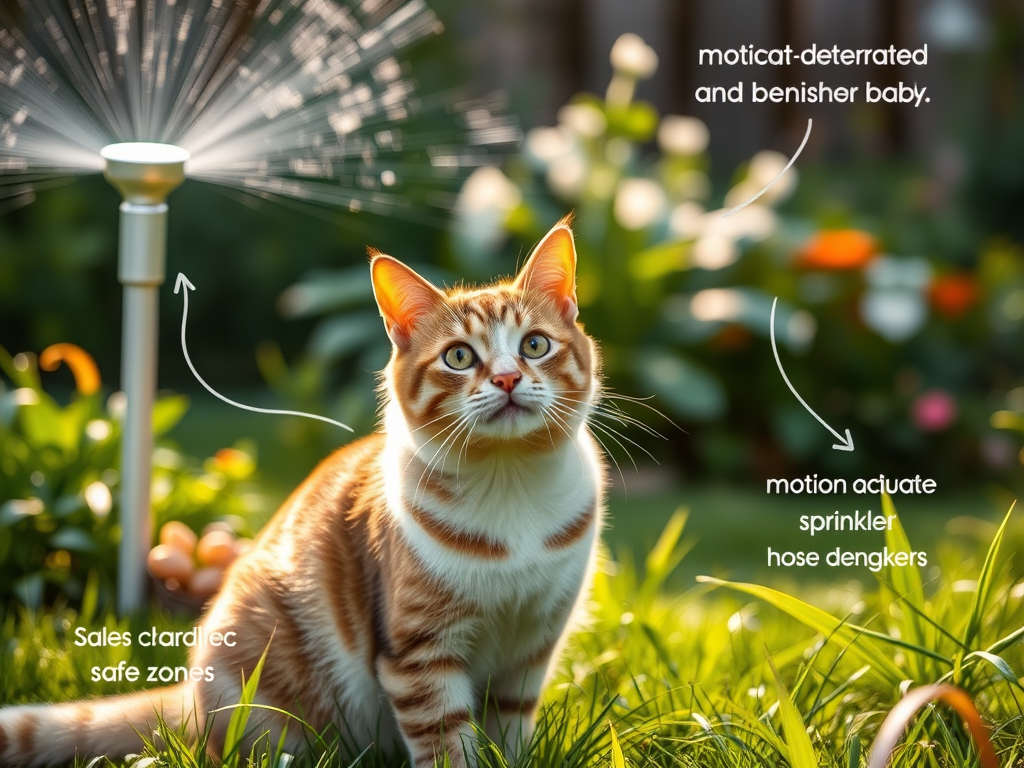Engaging Methods to Satisfy Your Cat's Hunting Instincts Safely
Mitigating Your Cat's Hunting Impact: Cats possess a strong instinct to hunt, a trait that has evolved over thousands of years. This behavior is not only natural but also essential for their mental and physical well-being. However, it is crucial to create a safe indoor environment that accommodates these instincts while protecting local wildlife populations. By designing stimulating and interactive spaces filled with activities that engage their senses, you can ensure your cat remains active and content indoors, thus preventing any negative consequences for outdoor animals. Your efforts will lead to a happier pet while contributing positively to the ecosystem.
Incorporating interactive toys into your cat's play routine is an excellent way to enhance their indoor hunting experience. Toys like feather wands, laser pointers, and battery-operated mice can captivate your cat for extended durations. These engaging toys mimic real-life hunting scenarios, allowing your feline friend to stalk, chase, and pounce, which provides vital mental stimulation and physical exercise. Moreover, playing with these toys not only keeps your cat entertained but also promotes their overall health by encouraging them to expend their energy in a constructive manner, ultimately leading to a more balanced lifestyle.
Transform your home into an exciting feline playground by constructing obstacle courses that feature various structures such as boxes, tunnels, and shelves. This dynamic environment encourages exploration and physical activity, prompting your cat to climb, jump, and discover new areas. Cats are inherently curious creatures, and by providing them with diverse play spaces, you can replicate an exhilarating natural habitat, allowing them to feel as if they are on a thrilling adventure right in their own home.
Don’t overlook the power of puzzle feeders. These innovative feeding tools add a layer of challenge for your cat, mirroring the effort they would typically expend during a hunt. By incorporating treat-dispensing puzzles into your cat's feeding routine, you can keep their minds sharp while providing an enjoyable and rewarding experience. This approach not only entertains your pet but also promotes healthier eating habits, as they learn to work for their food, making mealtime a more stimulating and engaging occasion.
Making playtime a priority in your home is crucial for your cat's happiness. Actively engaging in social interactions through play is essential for strengthening the bond between you and your feline companion. Set aside dedicated time for regular play sessions, using the same toys that your cat enjoys during their solo playtime. This shared experience not only helps alleviate any built-up frustration your cat may experience but also deepens the emotional connection between you two, making playtime a truly rewarding and fulfilling experience for both of you.
With a dash of creativity and commitment, you can cultivate a stimulating indoor atmosphere for your cat. Your home can become more than just a shelter; it can turn into an adventurous landscape that satisfies their natural hunting instincts while keeping them safe from external dangers. By thoughtfully planning and considering your cat's needs, you can ensure a happy and content indoor feline.

Mastering Leash Training for Safe Outdoor Adventures with Your Cat
Implementing leash training can open the door to safe and enjoyable outdoor exploration for your cat. While walks are typically a dog-centric activity, cats can also benefit from the great outdoors with the right approach and patience. By gradually introducing your furry friend to a harness and leash, you provide them with the opportunity to experience nature while ensuring their security and supervision.
Begin your leash training journey with a properly fitting harness that prioritizes your cat's comfort. Allow your pet to explore and become familiar with the harness before attempting to put it on. Let them sniff and inspect the harness at their own pace, which will help diminish any anxiety they may have. This gradual introduction fosters a positive association, making the entire process more enjoyable and successful for both of you.
Once your cat is comfortable with the harness, attach a lightweight leash and start practicing in the safety of your home. This familiar setting allows your feline to adjust to the sensation of wearing a leash, boosting their confidence. Take your time and be prepared for some initial hesitance; patience is vital in helping your cat acclimate to this new experience. Celebrate small victories along the way to encourage progress.
When you're ready to venture outside for the first time, choose a quiet and secure location, such as your backyard or a peaceful park. Ensure the area has minimal traffic and distractions to help your cat feel safe. Start with short outdoor sessions to prevent overwhelming your pet, gradually increasing the duration as they become more comfortable with exploring their new surroundings.
Supervised outdoor time can significantly enrich your cat's life, allowing them to relish the sights, sounds, and aromas of nature while protecting local wildlife. Picture the joy on your cat's face as they discover new experiences in a secure environment. This shared outdoor journey not only enhances their quality of life but also fortifies the bond between you and your beloved pet.
Real-life success stories from fellow cat owners can inspire you to embark on this journey. Many initially felt apprehensive about whether their cats would adapt to leash walking, yet they found that consistent training and positive reinforcement were key. Recognize and celebrate each small success as a step toward broadening your cat's horizons while ensuring their safety.
By adding leash training to your cat's routine, you facilitate a harmonious blend of outdoor enjoyment and wildlife protection. This balanced strategy allows your cat to explore their surroundings safely while fostering a sense of security in their environment, enriching their life in the process.
Creating Safe Outdoor Spaces: The Benefits of Catios for Your Feline Friend
Outdoor cat enclosures, often referred to as catios, provide an ideal solution for adventurous felines eager to explore the outdoors without facing inherent dangers. These secure spaces enable your cat to enjoy the fresh air and natural surroundings while ensuring their safety and that of local wildlife.
When constructing or purchasing a catio, it can be tailored to fit your specific space and budget. Options can range from simple balcony enclosures to elaborate backyard structures. The primary focus should be on making the enclosure escape-proof, as ensuring safety is paramount in providing a secure environment for your cat to explore.
As you design your catio, think about incorporating multiple levels and cozy hiding spots. Cats thrive in environments that offer vertical options and sheltered areas for retreat. By adding platforms, ramps, and hammocks, you can transform a basic enclosure into an exhilarating paradise that mimics their natural habitat, fostering their exploratory instincts.
Enhancing the sensory experience within the catio is equally important. Introduce elements such as cat grass, scratching posts, or logs to create an engaging environment filled with diverse textures and scents. This sensory enrichment keeps your cat stimulated and satisfied while allowing them to enjoy the outdoors in a controlled setting, boosting their overall happiness.
Regular maintenance is crucial for ensuring the safety of your catio. Routinely inspect it for wear and tear, including the integrity of the mesh, the structure, and the locks. Cats are naturally curious and may test the boundaries of their enclosure, so keeping it in top shape is essential for their well-being and security.
With a catio, your feline companion can bask in the sun, climb, and observe wildlife without posing a threat to local ecosystems. They can relish the outdoors while remaining safe, experiencing the joy of watching birds and other small creatures from their secure haven, which adds enrichment to their lives.

Effective Training Techniques to Deter Hunting Behaviors in Cats
Teaching your cat to reduce their hunting behaviors may appear challenging, but with the right techniques, it can become an achievable goal. The first step is to understand the natural instincts and behaviors that drive your cat to hunt, which is essential for implementing effective training strategies tailored to their needs.
Leveraging technology can greatly enhance your training efforts. Consider using motion-activated deterrents, such as sprinklers or noise-makers, to establish boundaries that discourage hunting without hindering their other activities. Strategically zoning your yard into safe areas can help redirect your cat's focus away from potential prey, promoting safer interactions with the environment.
Positive reinforcement is a core component of modifying your cat’s behavior. Reward them for exhibiting non-hunting actions with treats or affection. For example, if your cat responds to their name or refrains from chasing a potential target, reward them with a tasty treat or extra attention. This approach encourages them to repeat desirable behaviors while diminishing their instinctive urge to hunt, creating a more harmonious relationship.
Incorporating clicker training can also be an effective strategy. This method involves associating a distinct sound with positive actions, enabling your cat to connect their behavior with rewards. By clicking when they display desirable actions, you can reinforce good habits while clarifying your expectations, making training a more structured and enjoyable experience.
For more personalized advice, consider consulting with feline behavior specialists. They can provide tailored insights and techniques that address specific challenges you may face, helping you and your cat coexist harmoniously while being mindful of local wildlife.
The goal of using deterrents and training is not to punish but to guide your cat toward behaviors that prioritize their safety and the environment. With consistency and patience, you can successfully redirect their instincts, leading to safer outdoor interactions for both your cat and local wildlife.
Nutritional Approaches to Alleviate Hunting Drives in Cats
The type of food you provide and the feeding methods you adopt can significantly influence your cat's hunting instincts. Interestingly, a well-fed cat may still exhibit hunting behaviors; however, the way you feed them can help mitigate this drive. Understanding the relationship between nutrition and behavior is key.
Free feeding, which allows food to be available throughout the day, may not be ideal for every cat. Instead, consider establishing a structured feeding schedule. By creating predictable mealtimes, your cat may feel less inclined to hunt, as they learn to associate food with specific times of the day, thereby reducing the urge to seek out prey.
Interactive feeding strategies can be transformative for your cat's behavior. Utilizing food puzzles or dispensers can replicate the act of hunting, requiring your cat to ‘work’ for their meals. This not only keeps them mentally engaged but also channels their energy positively, allowing their natural instincts to be expressed safely and constructively.
It’s important to pay attention to the nutritional content of their diet as well. A high-protein, low-carbohydrate diet aligns better with a cat's natural dietary requirements, which may lead to a decrease in hunting behaviors. Collaborating with a veterinarian to customize their diet can ensure your cat's nutritional needs are effectively met while promoting overall health.
Lastly, offering a variety of food types can satisfy their inherent curiosity and appetite for novelty. Alternating between dry kibble, wet food, and raw diets can keep mealtime interesting, reducing the urge to seek excitement outside their food dish. This variety can also prevent boredom and encourage healthy eating habits.
Feeding strategies go beyond simply providing sustenance; they serve as powerful tools for managing your cat's behavior. By adjusting how and what you feed them, you can effectively curtail their inclination to hunt while keeping them satisfied, healthy, and engaged within the safety of your home.

Building Community Responsibility for Cat Conservation
Cats are cherished companions, and as their caretakers, we bear the responsibility to ensure they coexist peacefully with local wildlife. By embracing community involvement and personal accountability, we can significantly mitigate the ecological impact of free-roaming cats, creating a more balanced ecosystem.
Engaging with local conservation groups is an excellent way to stay informed about wildlife-friendly practices. Many communities offer educational workshops for cat owners, discussing the ecological consequences of allowing cats to roam freely and providing practical solutions to mitigate these effects. Knowledge is a powerful tool in creating positive change.
Consider initiating or participating in neighborhood discussions or social media groups focused on responsible pet ownership. Sharing resources, tips, and personal experiences can cultivate a wildlife-conscious community, fostering a supportive environment for all pet owners and promoting responsible cat care.
A proactive approach includes establishing cat-friendly zones within communal gardens or parks. These designated areas can feature enclosures or supervised play spaces, ensuring a safe environment for both cats and wildlife. This collaborative effort raises awareness and encourages positive interactions between pets and nature.
Incorporating family-friendly initiatives, such as sticker campaigns or educational contests for children and teens, can help raise awareness about responsible pet ownership and the importance of coexisting harmoniously with nature. Engaging the younger generation is vital for long-term change.
Lead by example at home by applying the strategies you’ve learned. Whether it’s leash training, building catios, or modifying feeding practices, demonstrating a commitment to a harmonious relationship between your cat and the environment can inspire others to follow suit.
By merging individual actions with community initiatives, we can create a supportive network that balances our cats’ needs with ecological stewardship. Together, we can cherish our pets while respecting and protecting the wild spaces around us, fostering a future where both cats and wildlife thrive.
The Article: Minimize Your Cat’s Hunting Impact Appeared First On Unity Pets.
The Article Minimize Hunting Impact of Your Cat Effectively Was Found On https://limitsofstrategy.com
The Article Effectively Minimise Your Cat’s Hunting Impact First Appeared ON
: https://ad4sc.com















Sophie McDaniel
I love how you’ve highlighted the importance of balancing our cats’ natural instincts with the need to protect wildlife! I’ve found that incorporating puzzle feeders has been a game changer for my cat. Not only does it engage her hunting instincts, but it also promotes mental stimulation as she figures out how to get her treats. It’s fascinating how these simple strategies can keep our feline friends active and entertained without them roaming outside. Have you found any other creative ways to enrich indoor spaces? It would be great to hear more ideas to keep the conversation going!